Magnetically Aligned Nanorods in Alginate Capsules (MANiACs): Soft Matter Tumbling Robots for Manipulation and Drug Delivery
Abstract
1. Introduction
2. Materials and Methods
2.1. Nanorod Synthesis
2.2. MANiAC Synthesis
2.3. Magnetic Manipulation of Capsules
2.4. Intestine Preparation for Tissue Surface Tumbling
2.5. SU-8 Microstructures Fabrication
2.6. Loading and Release Studies
3. Results and Discussion
3.1. Synthesis and Actuation of Magnetically Aligned Nanorod Alginate Capsules (MANiACs)
3.2. Magnetic Surface Tumbling
3.3. Climbing Inclined Surfaces and Pushing Millimeter-Scale Structures
3.4. Model Drug Loading, Release, and Combined Tumbling and Release
4. Conclusions
Supplementary Materials
Author Contributions
Funding
Acknowledgments
Conflicts of Interest
References
- Sitti, M.; Ceylan, H.; Hu, W.; Giltinan, J.; Turan, M.; Yim, S.; Diller, E. Biomedical Applications of Untethered Mobile Milli/Microrobots. Proc. IEEE 2015, 103, 205–224. [Google Scholar] [CrossRef]
- Li, J.; Esteban-Fernandez de Ávila, B.; Gao, W.; Zhang, L.; Wang, J. Micro/nanorobots for biomedicine: Delivery, surgery, sensing, and detoxification. Sci. Robot. 2017, 2, eaam6431. [Google Scholar] [CrossRef]
- Guix, M.; Weiz, S.M.; Schmidt, O.G.; Medina-Sanchez, M. Self-Propelled Micro/Nanoparticle Motors. Part. Part. Syst. Charact. 2018, 35, 1700382. [Google Scholar] [CrossRef]
- Jing, W.; Pagano, N.; Cappelleri, D.J. A novel micro-scale magnetic tumbling microrobot. J. Micro-Bio Robot. 2013, 8, 1–12. [Google Scholar] [CrossRef]
- Jing, W.; Cappelleri, D. A Magnetic Microrobot with in situ Force Sensing Capabilities. Robotics 2014, 3, 106–119. [Google Scholar] [CrossRef]
- Jing, W.; Cappelleri, D.J. Incorporating in situ force sensing capabilities in a magnetic microrobot. In Proceedings of the IEEE/RSJ International Conference on Intelligent Robots and Systems, Chicago, IL, USA, 14–18 September 2014; pp. 4704–4709. [Google Scholar] [CrossRef]
- Guix, M.; An, Z.; Wang, J.; Johnson, B.; Cappelleri, D.J. Vision-based micro-force sensing mobile microrobots for intelligent micromanipulation. In Proceedings of the IEEE International Conference on Robotics, Manipulation, and Automation at Small Scales (MARSS), Montreal, QC, Canada, 17–21 July 2017. [Google Scholar]
- Bi, C.; Guix, M.; Johnson, B.V.; Jing, W.; Cappelleri, D.J. Design of Microscale Magnetic Tumbling Robots for Locomotion in Multiple Environments and Complex Terrains. Micromachines 2018, 9, 65. [Google Scholar] [CrossRef]
- Jing, W.; Cappelleri, D.J. Micro-force sensing mobile microrobots. In Proc. SPIE 9494, Next-Generation Robotics II; and Machine Intelligence and Bio-inspired Computation: Theory and Applications IX; SPIE: Bellingham, WA, USA, 2015; Volume 9494, p. 949405. [Google Scholar]
- Aguero, L.; Zaldivar-Silva, D.; Pena, L.; Dias, M. Alginate microparticles as oral colon drug delivery device: A review. Carbohydr. Polym. 2017, 168, 32–43. [Google Scholar] [CrossRef]
- Lopes, M.; Abrahim, B.; Veiga, F.; Seiça, R.; Cabral, L.M.; Arnaud, P.; Andrade, J.C.; Ribeiro, A.J. Preparation methods and applications behind alginate-based particles. Expert Opin. Drug Deliv. 2017, 14, 769–782. [Google Scholar] [CrossRef] [PubMed]
- Paques, J.P.; van der Linden, E.; van Rijn, C.J.M.; Sagis, L.M.C. Preparation methods of alginate nanoparticles. Adv. Colloid Interface Sci. 2014, 209, 163–171. [Google Scholar] [CrossRef] [PubMed]
- Degen, P.; Zwar, E.; Schulz, I.; Rehage, H. Magneto-responsive alginate capsules. J. Phys. Condens. Matter 2015, 27, 194105. [Google Scholar] [CrossRef] [PubMed]
- Calafiore, R.; Basta, G.; Luca, G.; Lemmi, A.; Racanicchi, L.; Mancuso, F.; Montanucci, M.P.; Brunetti, P. Standard Technical Procedures for Microencapsulation of Human Islets for Graft into Nonimmunosuppressed Patients With Type 1 Diabetes Mellitus. Transplant. Proc. 2006, 38, 1156–1157. [Google Scholar] [CrossRef]
- Gonzalez-Pujana, A.; Orive, G.; Pedraz, J.L.; Santos-Vizcaino, E.; Hernandez, R.M. Alginate Microcapsules for Drug Delivery. In Alginates and Their Biomedical Applications; Rehn, B., Moradali, M., Eds.; Springer: Singapore, 2018; pp. 67–100. [Google Scholar] [CrossRef]
- Calafiore, R.; Basta, G.; Luca, G.; Lemmi, A.; Pia Montanucci, M.; Calabrese, G.; Racanicchi, L.; Mancuso, F.; Brunetti, P. Microencapsulated Pancreatic Islet Allograſts into Nonimmunosuppressed Patients with Type 1 Diabetes: First Two Cases. Diabetes Care 2006, 29, 137–138. [Google Scholar] [CrossRef] [PubMed]
- Tuch, B.E.; Keogh, G.W.; Williams, L.J.; Wu, W.; Foster, J.; Vaithilingam, V.; Phlips, R. Safety and Viability of Microencapsulated Human Islets Transplated Into Diabetic Humans. Diabetes Care 2009, 32, 1887–1889. [Google Scholar] [CrossRef] [PubMed]
- Basta, G.; Montanucci, P.; Luca, G.; Boselli, C.; Noya, G.; Barbaro, B.; Qi, M.; Kinzer, K.P.; Oberholzer, J.; Calafiore, R. Long-Term Metabolic and Immunological Follow-Up of Nonimmunosuppressed Patients with Type 1 Diabetes Treated with Microencapsulated Islet Allografts: Four cases. Diabetes Care 2011, 34, 2406–2409. [Google Scholar] [CrossRef] [PubMed]
- Ali, J.; Cheang, U.K.; Liu, Y.; Kim, H.; Rogowski, L.; Sheckman, S.; Patel, P.; Sun, W.; Kim, M.J. Fabrication and magnetic control of alginate-based rolling microrobots. AIP Adv. 2016, 6, 125205. [Google Scholar] [CrossRef]
- Fusco, S.; Sakar, M.S.; Kennedy, S.; Peters, C.; Bottani, R.; Starsich, F.; Mao, A.; Sotiriou, G.A.; Pané, S.; Pratsinis, S.E.; et al. An Integrated Microrobotic Platform for On-Demand, Targeted Therapeutic Interventions. Adv. Mater. 2014, 26, 952–957. [Google Scholar] [CrossRef]
- Paxton, W.F.; Kistler, K.C.; Olmeda, C.C.; Sen, A.; Angelo, S.K.S.; Cao, Y.; Mallouk, T.E.; Lammert, P.E.; Crespi, V.H. Catalytic Nanomotors: Autonomous Movement of Stripted Nanorods. J. Am. Chem. Soc. 2004, 126, 13424–13431. [Google Scholar] [CrossRef]
- Xu, T.; Yu, J.; Yan, X.; Choi, H.; Zhang, L. Magnetic Actuation Based Motion Control of Microrobots: An Overview. Micromachines 2015, 6, 1346–1364. [Google Scholar] [CrossRef]
- Wang, W.; Castro, L.A.; Hoyos, M.; Mallouk, T.E. Autonomous Motion of Metallic Microrods Propelled by Ultrasound. ACS Nano 2012, 6, 6122–6132. [Google Scholar] [CrossRef] [PubMed]
- Ahmed, S.; Wang, W.; Mair, L.O.; Fraleigh, R.D.; Li, S.; Castro, L.A.; Hoyos, M.; Huang, T.J.; Mallouk, T.E. Steering Acoustically Propelled Nanowire Motors toward Cells in a Biologically Compatible Environment Using Magnetic Fields. Langmuir 2013, 29, 16113–16118. [Google Scholar] [CrossRef]
- Wang, W.; Li, S.; Mair, L.; Ahmed, S.; Huang, T.J.; Mallouk, T.E. Acoustic Propulsion of Nanorod Motors Inside Living Cells. Angew. Chem. Int. Ed 2014, 126, 3265–3268. [Google Scholar] [CrossRef]
- Balk, A.L.; Mair, L.O.; Mathai, P.P.; Patrone, P.N.; Wang, W.; Ahmed, S.; Mallouk, T.E.; Liddle, J.A.; Stavis, S.M. Kilohertz Rotation of Nanorods Propelled by Ultrasound, Traced by Microvortex Advection of Nanoparticles. ACS Nano 2014, 8, 8300–8309. [Google Scholar] [CrossRef]
- Magdanz, V.; Medina-Sanchez, M.; Chen, Y.; Guix, M.; Schmidt, O.G. How to improve spermbot performance. Adv. Funct. Mater. 2015, 25, 2763–2770. [Google Scholar] [CrossRef]
- Schwarz, L.; Medina-Sánchez, M.; Schmidt, O.G. Hybrid BioMicromotors. Appl. Phys. Rev. 2017, 4, 031301. [Google Scholar] [CrossRef]
- Wang, W.; Duan, W.; Zhang, Z.; Sun, M.; Sen, A.; Mallouk, T.E. A tale of two forces: Simultaneous chemical and acoustic propulsion of bimetallic micromotors. Chem. Commun. 2015, 51, 1020–1023. [Google Scholar] [CrossRef] [PubMed]
- Chautems, C.; Zeydan, B.; Charreyron, S.; Chatzipirpiridis, G.; Pané, S.; Nelson, B.J. Magnetically powered microrobots: A medical revolution underway? Eur. J. Cardiothorac. Surg. 2017, 51, 405–407. [Google Scholar] [CrossRef] [PubMed]
- Alexiou, C.; Arnold, W.; Klein, R.J.; Parak, F.G.; Hulin, P.; Bergemann, C.; Erhardt, W.; Wagenpfeil, S.; Lubbe, A.S. Locoregional Cancer Treatment with Magnetic Drug Targeting. Cancer Res. 2000, 60, 6641–6648. [Google Scholar] [PubMed]
- Lubbe, A.S.; Alexiou, C.; Bergemann, C. Clinical applications of magnetic drug targeting. J. Surg. Res. 2001, 95, 200–206. [Google Scholar] [CrossRef]
- Mair, L.O.; Superfine, R. Single particle tracking reveals biphasic during nanorod magnetophoresis through extracellular matrix. Soft Matter 2014, 10, 4118–4125. [Google Scholar] [CrossRef]
- Shapiro, B.; Dormer, K.J.; Rutel, I.B. A two-magnet system to push therapeutic nanoparticles. AIP Conf. Proc. 2010, 1311, 77–88. [Google Scholar] [CrossRef]
- Nacev, A.; Weinberg, I.N.; Stepanov, P.Y.; Kupfer, S.; Mair, L.O.; Urdaneta, M.G.; Shimoji, M.; Fricke, S.T.; Shapiro, B. Dynamic Inversion Enables External Magnets To Concentrate Ferromagnetic Rods to a Central Target. Nano Lett. 2015, 15, 359–364. [Google Scholar] [CrossRef]
- Tierno, P.; Johansen, T.H.; Fischer, T.M. Magnetically driven colloidal microstirrer. J. Phys. Chem. B 2007, 111, 3077–3080. [Google Scholar] [CrossRef]
- Tierno, P.; Golestanian, R.; Pagonabarraga, I.; Sagués, F. Controlled swimming in confined fluids of magnetically actuated colloidal rotors. Phys. Rev. Lett. 2008, 101, 218304. [Google Scholar] [CrossRef] [PubMed]
- Güell, O.; Sagues, F.; Tierno, P. Magnetically driven Janus micro-ellipsoids realized via asymmetric gathering of the magnetic charge. Adv. Mater. 2011, 23, 3674–3679. [Google Scholar] [CrossRef] [PubMed]
- Mair, L.O.; Evans, B.; Hall, A.R.; Carpenter, J.; Shields, A.; Ford, K.; Millard, M.; Superfine, R. Highly controllable near-surface swimming of magnetic Janus nanorods: Application to payload capture and manipulation. J. Phys. Appl. Phys. 2011, 44, 125001. [Google Scholar] [CrossRef]
- Li, T.; Zhang, A.; Shao, G.; Wei, M.; Guo, B.; Zhang, G.; Li, L.; Wang, W. Janus Microdimer Surface Walkers Propelled by Oscillating Magnetic Fields. Adv. Funt. Mater. 2018, 28, 1706066. [Google Scholar] [CrossRef]
- Jiang, G.-L.; Guu, Y.-H.; Lu, C.-L.; Li, P.-N.; Shen, H.-M.; Lee, L.-S.; Yeh, J.A. Development of rolling magnetic microrobots. J. Micromech. Microeng. 2010, 20, 085042. [Google Scholar] [CrossRef]
- Hou, M.T.; Shen, H.; Jiang, G.; Lu, C.; Hsu, I.; Yeh, J.A. A rolling locomotion method for untethered magnetic microrobots. Appl. Phys. Lett. 2010, 96, 024102. [Google Scholar] [CrossRef]
- Sing, C.E.; Schmid, L.; Schneider, M.F.; Franke, T.; Alexander-Katz, A. Controlled surface-induced flows from the motion of self-assembled colloidal walkers. Proc. Natl. Acad. Sci. USA 2010, 107, 535–5340. [Google Scholar] [CrossRef] [PubMed]
- Zhang, L.; Petit, T.; Lu, Y.; Kratochvil, B.E.; Peyer, K.E.; Pei, R.; Lou, J.; Nelson, B.J. Controlled propulsion and cargo transport of rotating nickel nanowires near a patterned solid surface. ACS Nano 2010, 4, 6228–6234. [Google Scholar] [CrossRef]
- Gabayno, J.L.F.; Liu, D.; Chang, M.; Lin, Y. Controlled manipulation of Fe3O4 nanoparticles in an oscillating magnetic field for fast ablation of microchannel occlusion. Nanoscale 2015, 7, 3947–3953. [Google Scholar] [CrossRef] [PubMed]
- Mair, L.O.; Nacev, A.; Hilaman, R.; Stepanov, P.Y.; Chowdhury, S.; Jafari, S.; Hausfeld, J.; Karlsson, A.J.; Shirtliff, M.E.; Shapiro, B.; et al. Biofilm disruption with rotating microrods enhances antimicrobial efficacy. J. Magn. Magn. Mater. 2017, 427, 81–84. [Google Scholar] [CrossRef]
- Karle, M.; Wöhrle, J.; Miwa, J.; Paust, N.; Roth, G.; Zengerle, R.; Stetten, F.; Von Stetten, F. Controlled counter-flow motion of magnetic bead chains rolling along microchannels. Microfluid. Nanofluid. 2010, 10, 935–939. [Google Scholar] [CrossRef]
- Tung, H.-W.; Peyer, K.E.; Sargent, D.F.; Nelson, B.J. Noncontact manipulation using a transversely magnetized rolling robot. Appl. Phys. Lett. 2013, 103, 114101. [Google Scholar] [CrossRef]
- Petit, T.; Zhang, L.; Peyer, K.E.; Kratochvil, B.E.; Nelson, B.J. Selective trapping and manipulation of microscale objects using mobile microvortices. Nano Lett. 2012, 12, 156–160. [Google Scholar] [CrossRef] [PubMed]
- Vach, P.J.; Fratzl, P.; Klumpp, S.; Faivre, D. Fast Magnetic Micropropellers with Random Shapes. Nano Lett. 2015, 15, 7064–7070. [Google Scholar] [CrossRef] [PubMed]
- Mair, L.O.; Evans, B.A.; Nacev, A.; Stepanov, P.Y.; Hilaman, R.; Chowdhury, S.; Jafari, S.; Wang, W.; Shapiro, B.; Weinberg, I.N. Kilohertz Rotation of Nanorods Propelled by Ultrasound, Traced by Microvortex Advection of Nanoparticles. Nanoscale 2017, 9, 3375–3381. [Google Scholar] [CrossRef]
- Jing, W.; Chen, X.; Lyttle, S.; Fu, Z.; Shi, Y.; Cappelleri, D.J. A magnetic thin film microrobot with two operating modes. In Proceedings of the 2011 IEEE International Conference on Robotics and Automation, Shanghai, China, 9–13 May 2011; pp. 96–101. [Google Scholar] [CrossRef]
- Joshi, A.; Solanki, S.; Chaudhari, R.; Bahadur, D.; Aslam, M.; Srivastava, R. Multifunctional alginate microspheres for biosensing, drug delivery and magnetic resonance imaging. Acta Biomater. 2011, 7, 3955–3963. [Google Scholar] [CrossRef] [PubMed]
- Shen, F.; Poncet-Legrand, C.; Somers, S.; Slade, A.; Yip, C.; Duft, A.M.; Winnik, F.M.; Chang, P.L. Properties of a novel magnetized alginate for magnetic resonance imaging. Biotechnol. Bioeng. 2003, 83, 282–292. [Google Scholar] [CrossRef] [PubMed]
- Garcia, A.R.; Lacko, C.; Snyder, C.; Bohórquez, A.C.; Schmidt, C.E.; Rinaldi, C. Processing-size correlations in the preparation of magnetic alginate microspheres through emulsification and ionic crosslinking. Colloids Surf. Physicochem. Eng. Asp. 2017, 529, 119–127. [Google Scholar] [CrossRef] [PubMed]
- Degen, P.; Leick, S.; Siedenbiedel, F.; Rehage, H. Magnetic switchable alginate beads. Colloid Polym. Sci. 2012, 290, 97–106. [Google Scholar] [CrossRef]
- Brulé, S.; Levy, M.; Wilhelm, C.; Letourneur, D.; Gazeau, F.; Ménager, C.; Le Visage, C. Doxorubicin release triggered by alginate embedded magnetic nanoheaters: A combined therapy. Adv. Mater. 2011, 23, 787–790. [Google Scholar] [CrossRef]
- Alshehri, A.M.; Wilson, O.C.; Dahal, B.; Philip, J.; Luo, X.; Raub, C.B. Magnetic nanoparticle-loaded alginate beads for local micro-actuation of in vitro tissue constructs. Colloids Surf. B Biointerfaces 2017, 159, 945–955. [Google Scholar] [CrossRef]
- Barnett, B.P.; Arepally, A.; Karmarkar, P.V.; Qian, D.; Gilson, W.D.; Walczak, P.; Howland, V.; Lawler, L.; Lauzon, C.; Stuber, M.; et al. Magnetic resonance–guided, real-time targeted delivery and imaging of magnetocapsules immunoprotecting pancreatic islet cells. Nat. Med. 2007, 13, 986–991. [Google Scholar] [CrossRef] [PubMed]
- Barnett, B.P.; Arepally, A.; Stuber, M.; Arifin, D.R.; Kraitchman, D.L.; Bulte, J.W.M. Synthesis of magnetic resonance-, X-ray- and ultrasound-visible alginate microcapsules for immunoisolation and noninvasive imaging of cellular therapeutics. Nat. Protoc. 2011, 6, 1142–1151. [Google Scholar] [CrossRef] [PubMed]
- Arifin, D.R.; Valdeig, S.; Anders, R.A.; Bulte, J.W.M.; Weiss, C.R. Magnetoencapsulated human islets xenotransplanted into swine: A comparison of different transplantation sites. Xenotransplantation 2016, 23, 211–221. [Google Scholar] [CrossRef] [PubMed]
- Kim, J.; Arifin, D.R.; Muja, N.; Kim, T.; Gilad, A.A.; Kim, H.; Arepally, A.; Hyeon, T.; Bulte, J.W.M. Multifunctional Capsule-in-Capsules for Immunoprotection and Trimodal Imaging. Angew. Chem. Int. Ed Engl. 2011, 50, 2317–2321. [Google Scholar] [CrossRef] [PubMed]
- Mills, P.H.; Hitchens, T.K.; Foley, L.M.; Link, T.; Ye, Q.; Weiss, C.R.; Thompson, J.D.; Gilson, W.D.; Arepally, A.; Melick, J.A.; et al. Automated detection and characterization of SPIO-labeled cells and capsules using magnetic field perturbations. Magn. Reson. Med. 2012, 67, 278–289. [Google Scholar] [CrossRef]
- Finotelli, P.V.; Da Silva, D.; Sola-Penna, M.; Rossi, A.M.; Farina, M.; Andrade, L.R.; Takeuchi, A.Y.; Rocha-Leão, M.H. Microcapsules of alginate/chitosan containing magnetic nanoparticles for controlled release of insulin. Colloids Surf. B Biointerfaces 2010, 81, 206–211. [Google Scholar] [CrossRef]
- Wang, G.-J.; Lin, Y.-C.; Li, C.-W.; Hsueh, C.-C.; Hsu, S.-H.; Hung, H.-S. Fabrication of orderly nanostructured PLGA scaffolds using anodic aluminum oxide templates. Biomed. Microdevices 2009, 11, 843–850. [Google Scholar] [CrossRef]
- Miyashita, S.; Guitron, S.; Yoshida, K.; Li, S.; Damian, D.D.; Rus, D. Ingestible, Controllable, and Degradable Origami Robot for Patching Stomach Wounds. In Proceedings of the 2016 IEEE International Conference on Robotics and Automation (ICRA), Stockholm, Sweden, 16–21 May 2016; pp. 909–916. [Google Scholar] [CrossRef]
- Martin, C.R. Nanomaterials: A Membrane-Based Synthetic Approach. Science 1994, 266, 1961–1966. [Google Scholar] [CrossRef] [PubMed]
- Qin, J.; Nogués, J.; Mikhaylova, M.; Roig, A.; Muñoz, J.S.; Muhammed, M. Differences in the magnetic properties of Co, Fe, and Ni 250-300 nm wide nanowires electrodeposited in amorphous anodized alumina templates. Chem. Mater. 2005, 17, 1829–1834. [Google Scholar] [CrossRef]
- Hurst, S.J.; Payne, E.K.; Qin, L.; Mirkin, C.A. Multisegmented one-dimensional nanorods prepared by hard-template synthetic methods. Angew. Chem. Int. Ed. 2006, 45, 2672–2692. [Google Scholar] [CrossRef] [PubMed]
- Paredes-Juarez, G.A.; De Haan, B.J.; Faas, M.M.; De Vos, P. The role of pathogen-associated molecular patterns in inflammatory responses against alginate based microcapsules. J. Control. Release 2013, 172, 983–992. [Google Scholar] [CrossRef] [PubMed]
- Paredes-Juarez, G.A.; de Vos, P.; Bulte, J.W.M. Recent progress in the use and tracking of transplanted islets as a personalized treatment for type 1 diabetes. Expert Rev. Precis. Med. Drug Dev. 2017, 2, 57–67. [Google Scholar] [CrossRef] [PubMed]
- Schuerle, S.; Erni, S.; Flink, M.; Kratochvil, B.E.; Nelson, B.J. Three-Dimensional Magnetic Manipulation of Micro- and Nanostructures for Applications in Life Sciences. IEEE Trans. Magn. 2013, 49, 321–330. [Google Scholar] [CrossRef]
- Taylor, R.M. Video Spot Tracker software, Version 6.04. Available online: http://cismm.web.unc.edu/software/ (accessed on 31 March 2019).
- Keshoju, K.; Xing, H.; Sun, L. Magnetic field driven nanowire rotation in suspension. Appl. Phys. Lett. 2007, 91, 123114. [Google Scholar] [CrossRef]
- Stoner, E.C.; Wohlfarth, E.P. A Mechanism of Magnetic Hystersis in Heterogeneous Alloys. Philos. Trans. R. Soc. Lond. Ser. Math. Phys. Sci. 1948, 240, 599–642. [Google Scholar] [CrossRef]
- Balk, A.L.; Mair, L.O.; Guo, F.; Hangarter, C.; Mathai, P.P.; Mcmichael, R.D.; Stavis, S.M.; Unguris, J. Quantitative magnetometry of ferromagnetic nanorods by microfluidic analytical magnetophoresis. J. Appl. Phys. 2015, 118, 093904. [Google Scholar] [CrossRef]
- Mair, L.; Ford, K.; Alam, M.R.; Kole, R.; Fisher, M.; Superfine, R. Size-Uniform 200 nm Particles: Fabrication and Application to Magnetofection. J. Biomed. Nanotechnol. 2009, 5, 182–191. [Google Scholar] [CrossRef] [PubMed]
- Goldman, A.J.; Cox, R.G.; Brenner, H. Slow Viscous Motion of a Sphere Parallel to a Plane Wall I: Motion through a Quiscent Fluid. Chem. Eng. Sci. 1967, 22, 637–651. [Google Scholar] [CrossRef]
- Feuillebois, F.; Gensdarmes, F.; Mana, Z.; Ricciardi, L.; Monier, C.; Le Meur, G.; Reynaud, C.; Rabaud, M. Three-dimensional motion of particles in a shear flow near a rough wall. J. Aerosol Sci. 2016, 96, 69–95. [Google Scholar] [CrossRef]
- Hsu, R.; Ganatos, P. Gravitational and zero-drag motion of a spheroid adjacent to an inclined plane at low-Reynolds Number. J. Fluid Mech. 1994, 268, 267–292. [Google Scholar] [CrossRef]
- Chaoui, M.; Feuillebois, F. Creeping Flow Around a Sphere in a Shear Flow Close to a Wall. Q. J. Mech. Appl. Math. 2003, 56, 381–410. [Google Scholar] [CrossRef]
- Kuo, C.-W.; Lai, J.-J.; Wei, K.H.; Chen, P. Studies of Surface-Modified Gold Nanowires Inside Living Cells. Adv. Funct. Mater. 2007, 17, 3707–3714. [Google Scholar] [CrossRef]
- Tung, H.W.; Sargent, D.F.; Nelson, B.J. Protein crystal harvesting using the RodBot: A wireless mobile microrobot. J. Appl. Crystallogr. 2014, 47, 692–700. [Google Scholar] [CrossRef]
- Jain, D.; Bar-Shalom, D. Alginate drug delivery systems: Application in context of pharmaceutical and biomedical research. Drug Dev. Ind. Pharm. 2014, 40, 1576–1584. [Google Scholar] [CrossRef] [PubMed]
- Esteban-Fernández de Ávila, B.; Angsantikul, P.; Li, J.; Lopez-Ramirez, M.A.; Ramírez-Herrera, D.E.; Thamphiwatana, S.; Chen, C.; Delezuk, J.; Samakapiruk, R.; Ramez, V.; et al. Micromotor-enabled active drug delivery for in vivo treatment of stomach infection. Nat. Commun. 2017, 8, 272. [Google Scholar] [CrossRef] [PubMed]
- Li, J.; Thamphiwatana, S.; Liu, W.; Esteban-Fernández de Ávila, B.; Angsantikul, P.; Sandraz, E.; Wang, J.; Xu, T.; Soto, F.; Ramez, V.; et al. An Enteric Micromotor Can Selectively Position and Spontaneously Propel in the Gastrointestinal Tract. ACS Nano 2016, 10, 9536–9542. [Google Scholar] [CrossRef] [PubMed]
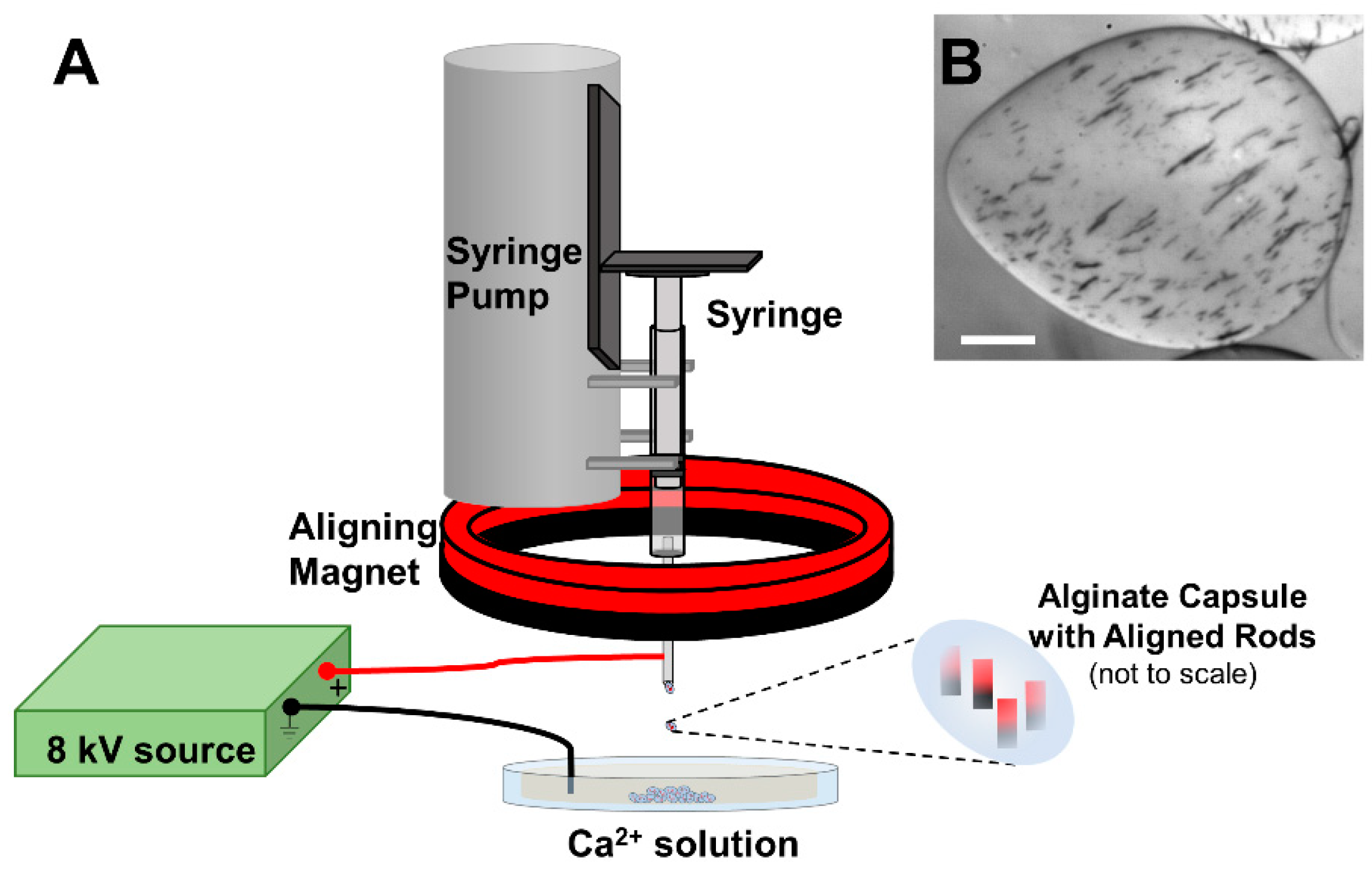
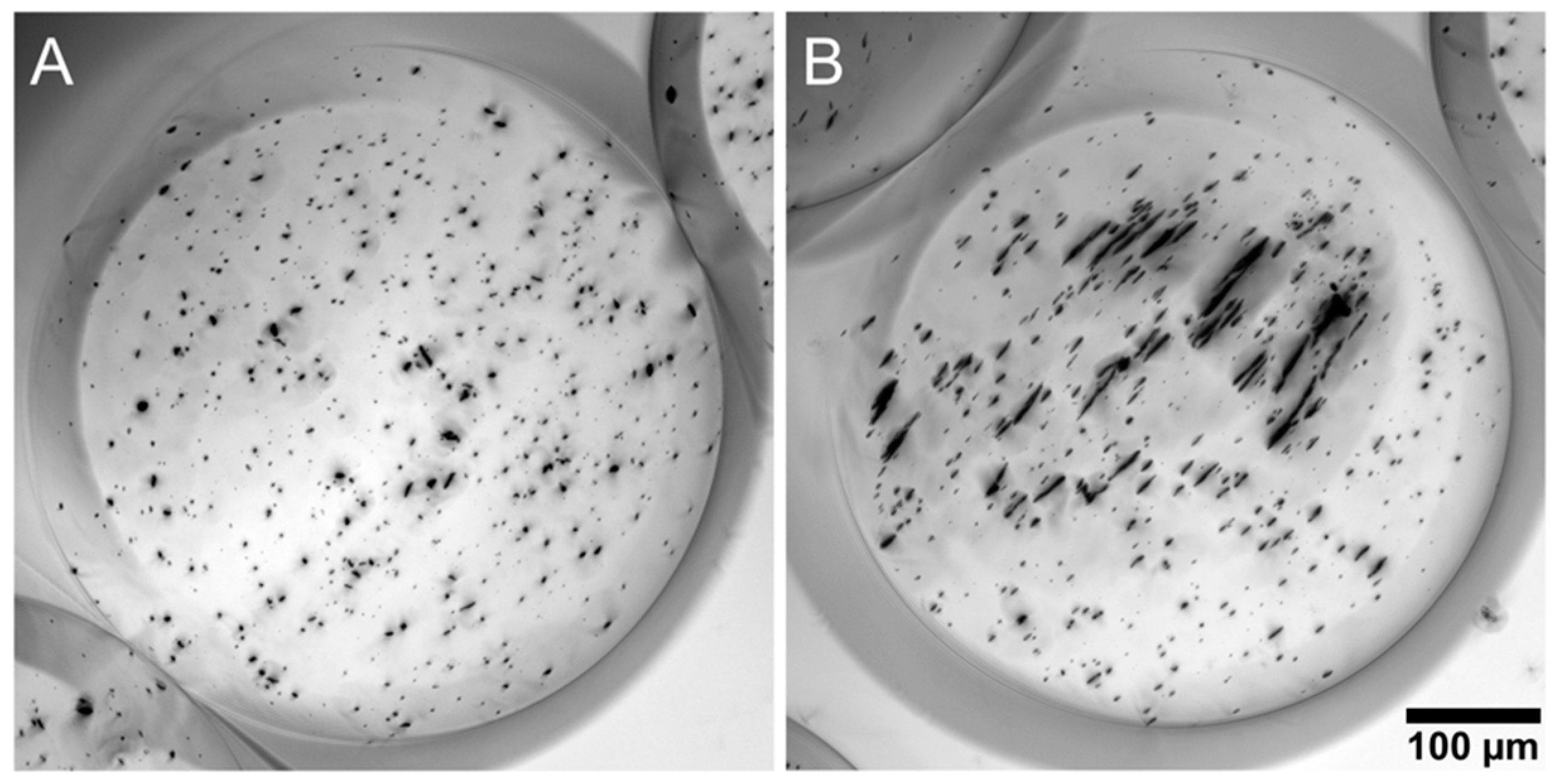
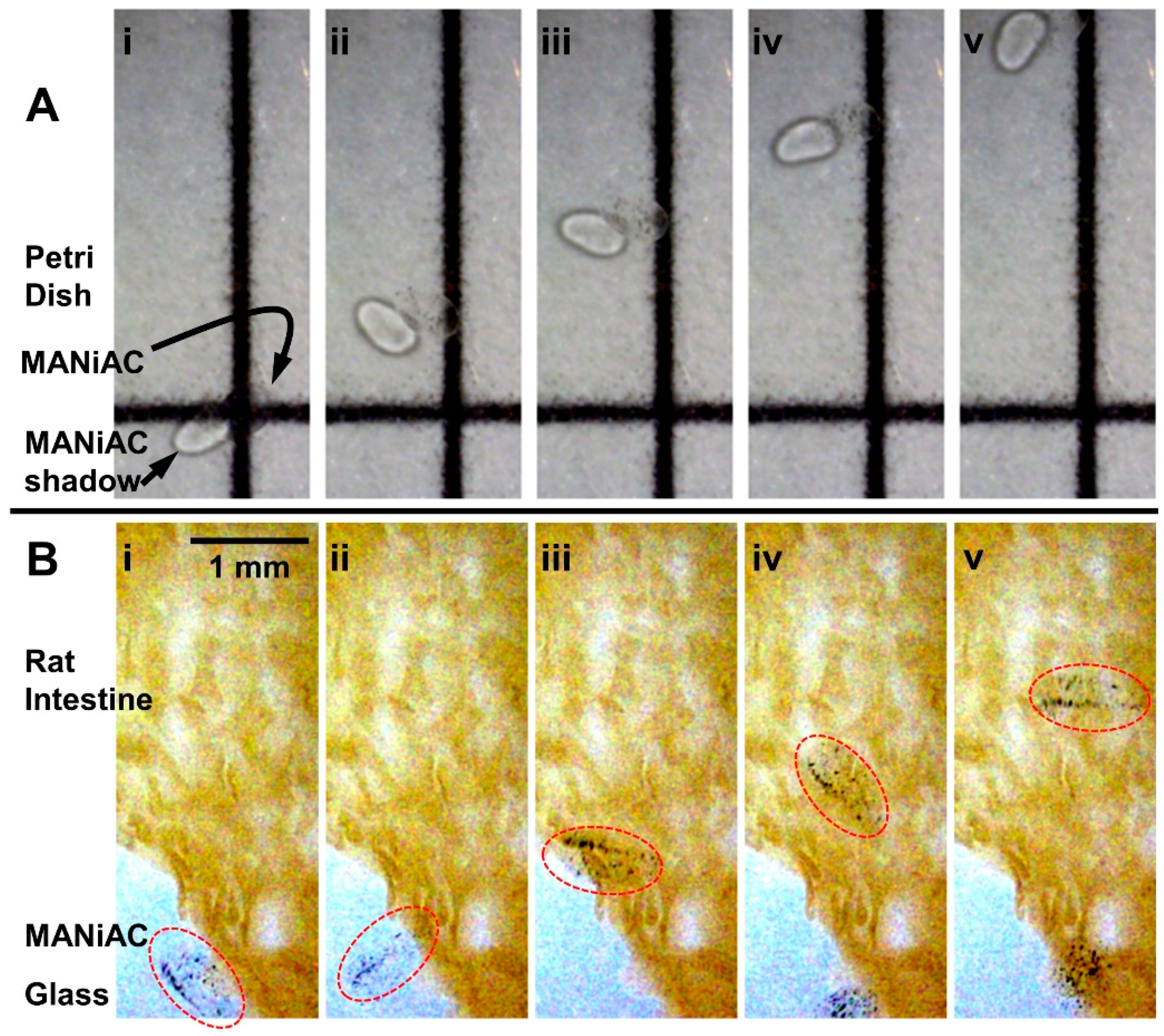
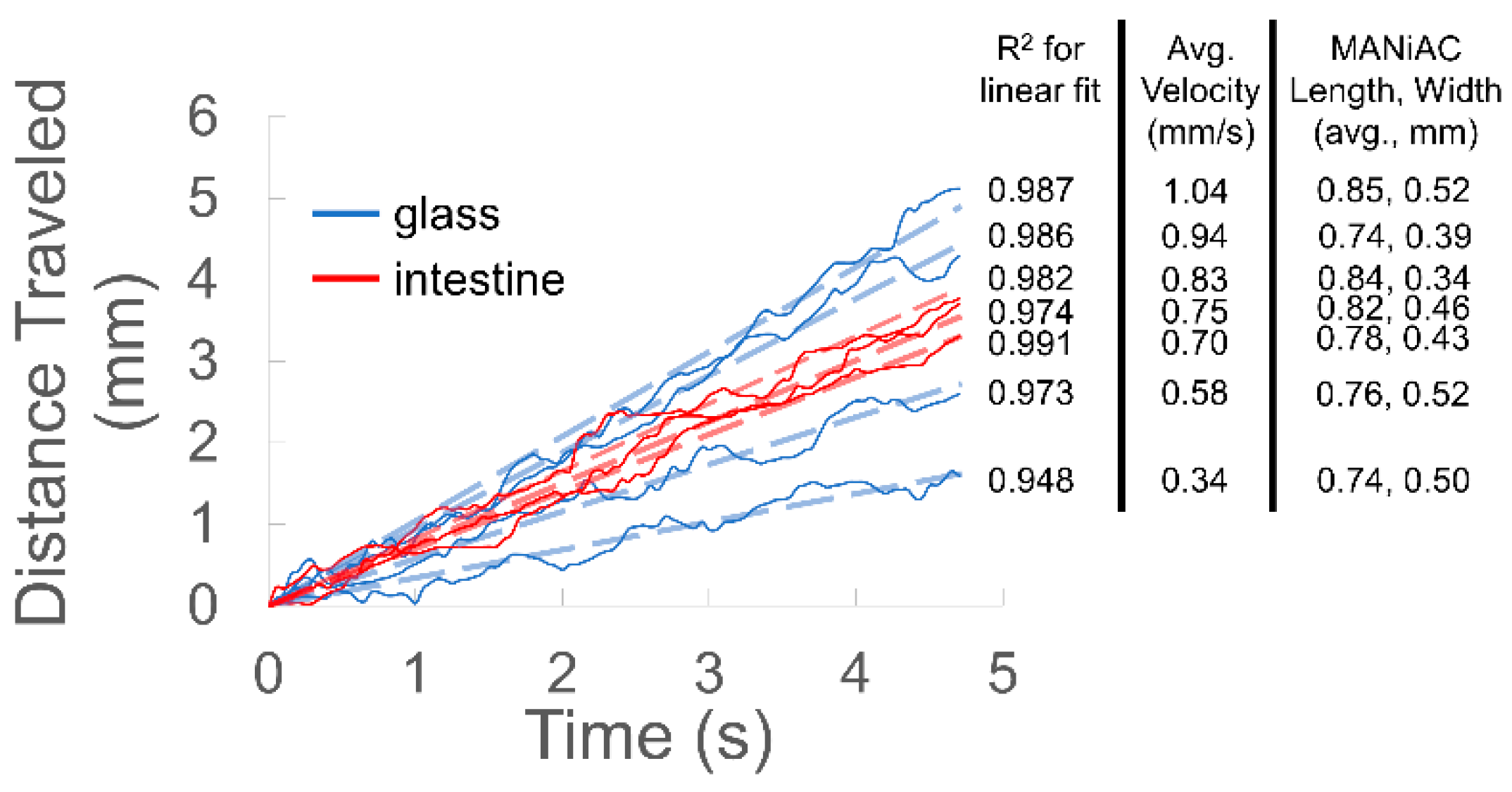

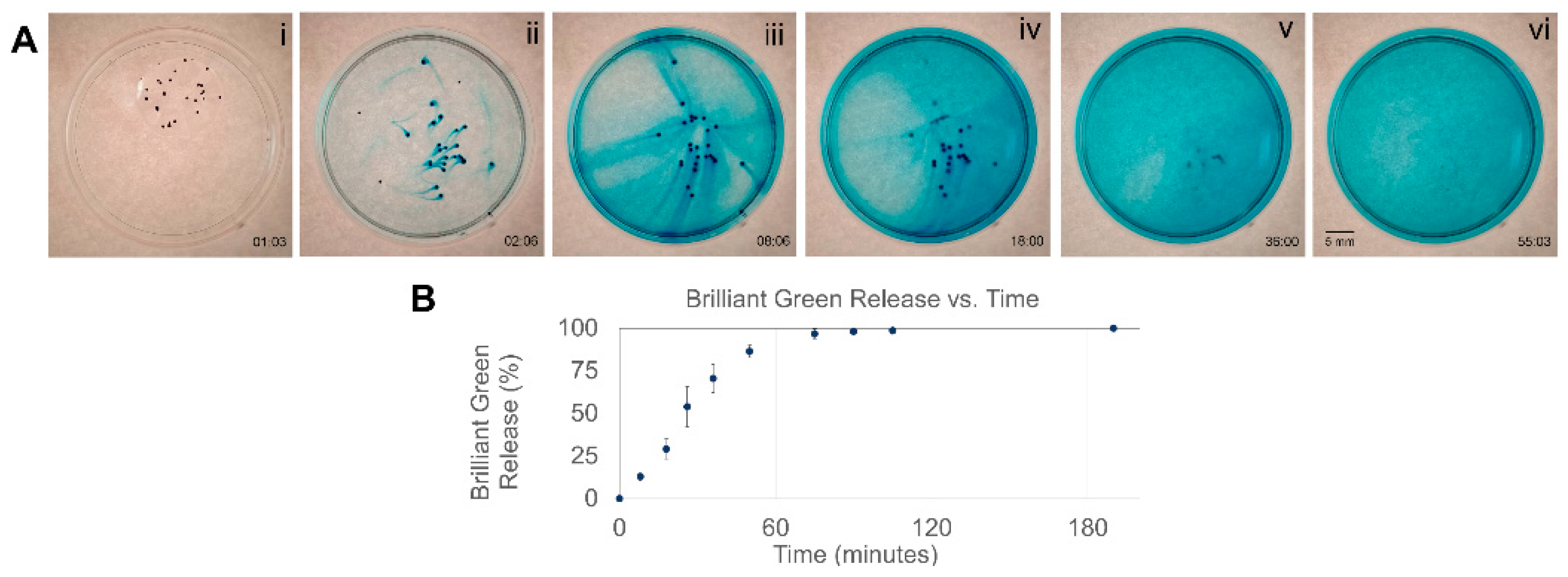
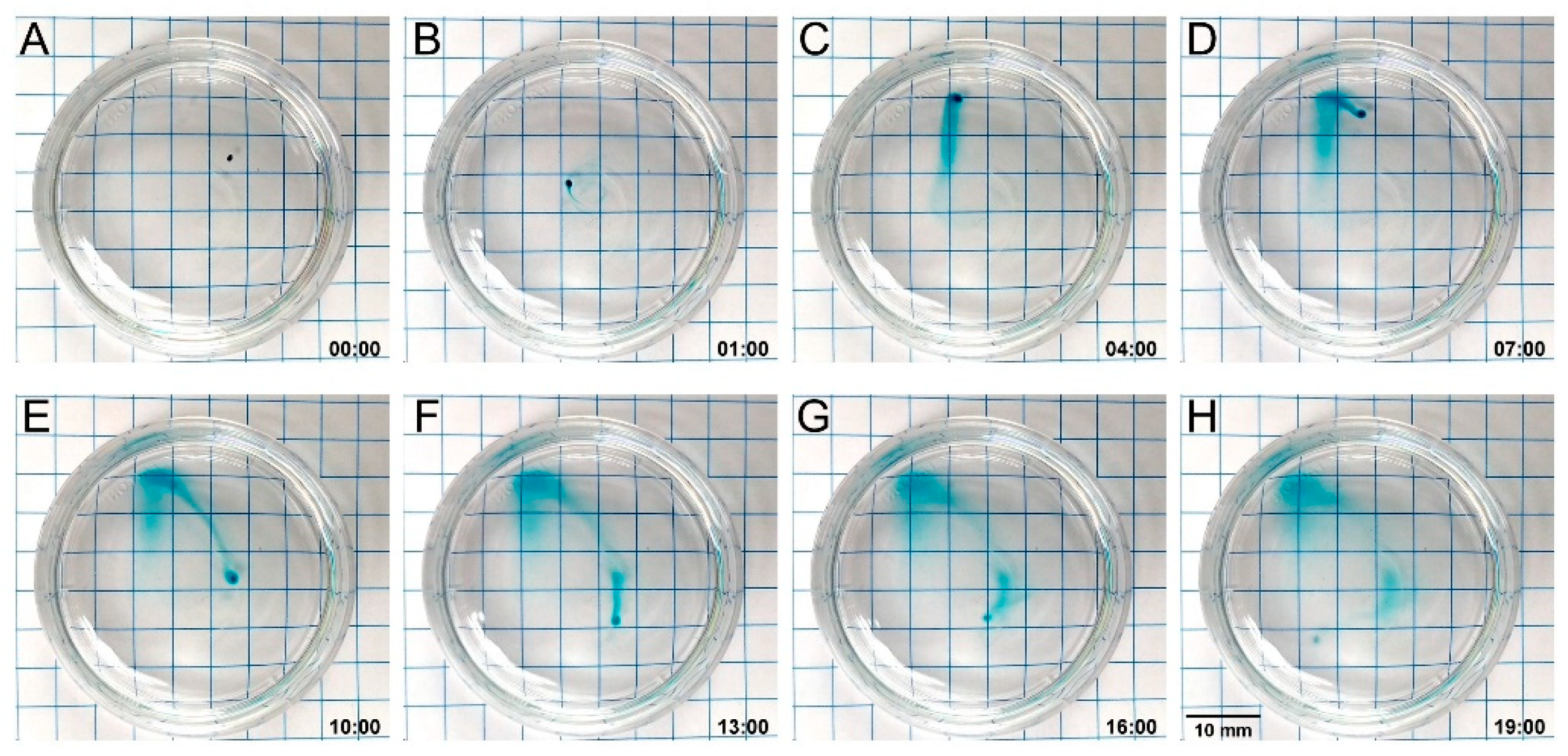
© 2019 by the authors. Licensee MDPI, Basel, Switzerland. This article is an open access article distributed under the terms and conditions of the Creative Commons Attribution (CC BY) license (http://creativecommons.org/licenses/by/4.0/).
Share and Cite
Mair, L.O.; Chowdhury, S.; Paredes-Juarez, G.A.; Guix, M.; Bi, C.; Johnson, B.; English, B.W.; Jafari, S.; Baker-McKee, J.; Watson-Daniels, J.; et al. Magnetically Aligned Nanorods in Alginate Capsules (MANiACs): Soft Matter Tumbling Robots for Manipulation and Drug Delivery. Micromachines 2019, 10, 230. https://doi.org/10.3390/mi10040230
Mair LO, Chowdhury S, Paredes-Juarez GA, Guix M, Bi C, Johnson B, English BW, Jafari S, Baker-McKee J, Watson-Daniels J, et al. Magnetically Aligned Nanorods in Alginate Capsules (MANiACs): Soft Matter Tumbling Robots for Manipulation and Drug Delivery. Micromachines. 2019; 10(4):230. https://doi.org/10.3390/mi10040230
Chicago/Turabian StyleMair, Lamar O., Sagar Chowdhury, Genaro A. Paredes-Juarez, Maria Guix, Chenghao Bi, Benjamin Johnson, Bradley W. English, Sahar Jafari, James Baker-McKee, Jamelle Watson-Daniels, and et al. 2019. "Magnetically Aligned Nanorods in Alginate Capsules (MANiACs): Soft Matter Tumbling Robots for Manipulation and Drug Delivery" Micromachines 10, no. 4: 230. https://doi.org/10.3390/mi10040230
APA StyleMair, L. O., Chowdhury, S., Paredes-Juarez, G. A., Guix, M., Bi, C., Johnson, B., English, B. W., Jafari, S., Baker-McKee, J., Watson-Daniels, J., Hale, O., Stepanov, P., Sun, D., Baker, Z., Ropp, C., Raval, S. B., Arifin, D. R., Bulte, J. W. M., Weinberg, I. N., ... Cappelleri, D. J. (2019). Magnetically Aligned Nanorods in Alginate Capsules (MANiACs): Soft Matter Tumbling Robots for Manipulation and Drug Delivery. Micromachines, 10(4), 230. https://doi.org/10.3390/mi10040230





